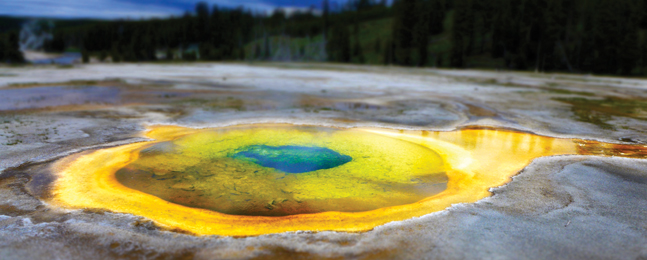Ancestry of an Enzyme

Julia Kern
HARDY: The colors in this Yellowstone hot spring show bacteria that survive as temperatures drop.
by Lawrence Goodman
Some 3 billion years ago, when life on this planet was still in its infancy, hot springs, geysers and volcanic hydrothermal vents were teeming with single-cell organisms. Temperatures hovered around a burning-hot 180 degrees Celsius. Fast-forward a few hundred million years, and the basic elements of our genetic code and cellular machinery were in place.
Then the Earth started to get colder. Standing on the equator 1 billion years ago, you would have felt as cold as if you were in today’s Antarctic.
This story has a happy ending, of course — life kept right on developing, despite the radical change in temperature. But how it managed to adapt to the Earth’s cooling has remained something of a mystery. In a recent cover story in the journal Science, biochemistry professor Dorothee Kern offers an explanation: A “super-enzyme” was able to brave the cold.
“It’s one more clue to how life evolved on this planet,” she says.
Kern, a Howard Hughes Medical Institute Investigator (and one-time East German basketball champion), has long been interested in enzymes, which act as key catalysts in cells.
Five years ago, Kern began building replicas of ancient, extinct enzymes. By analyzing the genetic code of thousands of species of bacteria, her research team created an evolutionary tree, then worked backward to infer the structures of an enzyme called adenylate kinase (ADK), from 3 billion years ago up to its modern forms. ADK is present in every living creature on Earth.
The team studied the behavior of this enzyme across a wide range of temperatures, essentially re-enacting several billion years’ worth of evolution in a few days. What they found was that, over time, ADK underwent genetic mutations so that it could swap out a key component — amino acids — which enabled it to cope with the inevitable loss of energy due to the decrease in environmental temperatures. As a result, ADK remained highly active despite the energy loss.
Kern created a model of what she calls a super-enzyme, an ADK able to survive in both hot and cold climates, which would have served as a transitional molecule as life adapted to a changing environment.
The existence of such a super-enzyme disproves a long-held theory: that increased enzyme activity is counterbalanced by decreased chemical stability. Kern’s super-enzymes were highly active yet didn’t grow more unstable.
Enzymes, it appears, are a lot more adaptable than previously thought.
